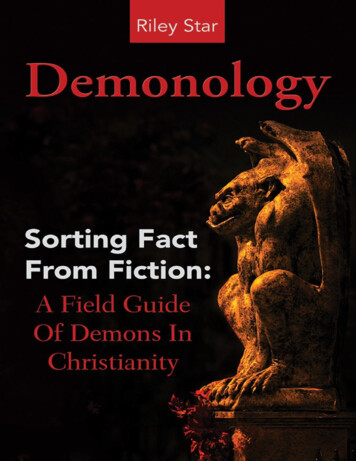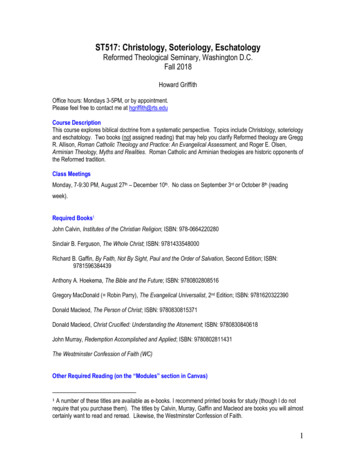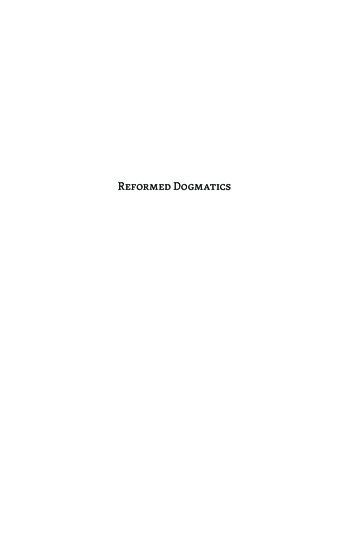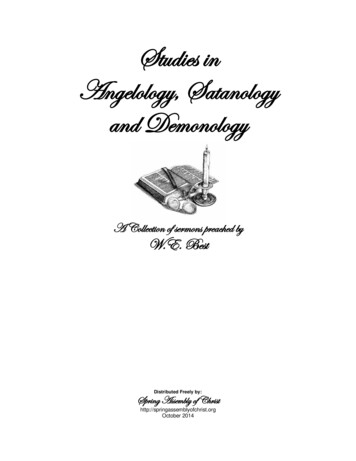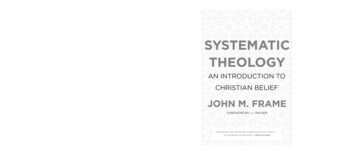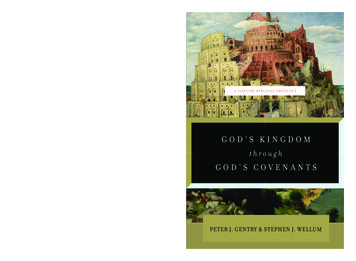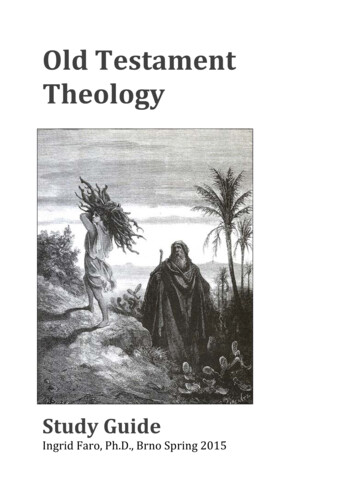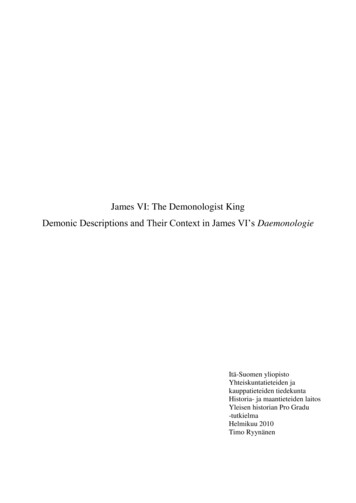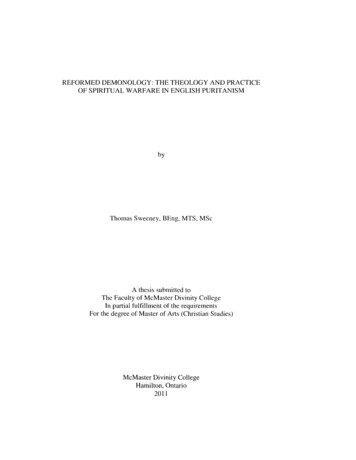
Transcription
REFORMED DEMONOLOGY: THE THEOLOGY AND PRACTICEOF SPIRITUAL WARFARE IN ENGLISH PURITANISMbyThomas Sweeney, BEng, MTS, MScA thesis submitted toThe Faculty of McMaster Divinity CollegeIn partial fulfillment of the requirementsFor the degree of Master of Arts (Christian Studies)McMaster Divinity CollegeHamilton, Ontario2011
Master of Arts (Christian Studies)Hamilton, OntarioMcMASTER DIVNITY COLLEGETITLE:Reformed Demonology: The Theology and Practice of SpiritualWarfare in English PuritanismAUTHOR:Thomas SweeneySUPERVISOR(S):Gordon HeathNUMBER OF PAGES:vi 1371l
McMASTER DIVINITY COLLEGEupon the recommendation of an oral examining committee,this thesis byThomas sweeneyis hereby accepted in partial fulfillment of the requirements for the degree ofMaster of Arts Christian Studies Academic DeanDate: November 28, 2011lll
ABSTRACT"Reformed Demonology: The Theology and Practice of Spiritual Warfare in English Puritanism"Thomas SweeneyMcMaster Divinity CollegeHamilton, OntarioMaster of Theological Studies, 200 lThe Puritan theology and practice of spiritual warfare differed in significant ways fromthat of their medieval precursors and their Roman Catholic contemporaries. These differencesare primarily attributable to the Puritan doctrines of divine sovereignty and human depravity.Puritan theology and practice is categorized under four systematic headings of demonology: theorigin and nature of Satan and his demons; demonic operations in history; how Satan assaultsbelievers today; and how Christians can defend themselves from those assaults. Each chapterdraws together the teaching found in Puritan spiritual warfare literature about that heading anddemonstrates how the doctrines of divine sovereignty and human depravity undergird thatteaching. The thesis concludes by proposing some historically responsible applications formodern-day spiritual warfare practitioners from the Puritans.IV
TABLE OF CONTENTSINTRODUCTION . 1The History of the History of Puritanism . 2Historical Works on Puritan Spiritual Warfare . 7Practical Works on Puritan Spiritual Warfare . 19Methodology . 25Primary Sources . 27CHAPTER ONE: ORIGIN AND NATURE . 33Origin . 33Nature . 351. Being and Character . 352. Power . 383. Limitations. 44Conclusion. 52CHAPTER TWO: OPERATIONS IN HISTORY . 54The Fall of Humanity . 54The Temptation of Christ . 57Conclusion . 65CHAPTER THREE: TYPES OF DEMONIC ASSAULTS . 66Temptations . 661. Drawing Souls to Sin . 672. Diverting Souls from their Duties . 713. Diluting Pure Doctrine . 754. Disguising a Soul's Spiritual State . 775. The Tactics of Temptation . 82Other Demonic Assaults . 87Conclusion. 90CHAPTER FOUR: CHRISTIAN RESISTANCE . 91How Not to Resist . 91Resisting Temptations . 971. Resisting Being Drawn to Sin . 972. Resisting Diversions from Duty . 1013. Resisting the Dilution of Pure Doctrine . 1044. Resisting the Disguise of the Soul's Spiritual State . 1085. Resisting Temptations in General . 113Resisting Other Assaults . 117Conclusion. 119CONCLUSION . 121Application . 1251. General Uses . 1262. Specific Uses . 127Conclusion. 130BIBLIOGRAPHY . 132Primary Sources . 132Secondary Sources . 133v
VI
1INTRODUCTIONThe Western church has experienced an explosion of popular interest in spiritual warfareover the last forty years. 1 Unfortunately, the literature of this movement has typically neglectedthe hard-won insights the church has gathered over two millennia of reflection and praxis. Mostdeliverance methods are built from a mix of personal experience, anecdotal accounts and Biblicalstudy, woven together with theological reflection of varying levels of sophistication. Thisapproach neglects one of the critical building blocks found in other fields of practical theology:historical research. Even when spiritual warfare writers delve into the past, they often commithistorical errors. For instance, in Peter Wagner's book on strategic-level spiritual warfare, onechapter purports to show historical examples of this practice. 2 However, his approach is ananachronistic effort to read modem situations back into the past, reducing the historicalenterprise to a mere propaganda effort. 3In an attempt to make the resources of the Christian past accessible to modem practitionersin a historically responsible way, this thesis will explore the theology and practice of spiritualwarfare of the English Puritans. Renowned for being "without peer as diagnosticians of thehuman heart," the Puritans generated a rich body of literature on the machinations of the Deviland how Christians can successfully resist them. 4 Furthermore, Puritan demonology avoids theextremes in modem demonology. On the one end of the continuum is a denial of the existence ofSatan, whether formally or simply informally by acknowledging his existence in the abstract but1Powlinson has identified four distinct movements of "demon deliverance ministry,"' all of which have arisen "onlysince the late 1960s." See Powlison, "Deliverance Ministry in Historical Perspective," 21.2Chapter 4 "Probing History" in Wagner, Confronting the Powers, 91-120.3For this and other common historical fallacies, see Tosh, The Pursuit of History, 12.4Shepherd, Historical Theology, Track F4.
2never considering his activity in the believer's life and stoutly resisting any teaching that does.On the other end is an obsession with demonic activity that attributes all evil, or eveninconvenient occurrences, to Satan. This view is often coupled with a conviction that the onlysuitable response to, or prevention of, these demonic assaults are "power encounters," or intenseprayer sessions to cast out or repel the offending spirits. The Puritans strike a middle roadbetween these approaches. On the one hand they take the Devil very seriously in their daily lives,but their primary response to this activity is active discipleship- although they were not afraid toconduct an exorcism when the situation called for it. Therefore, the Puritans make potentiallyhelpful historical conversation partners for today' s deliverance ministers.This thesis will demonstrate that Puritan demonology and practice of spiritual warfare wasguided by two core theological convictions of Post-Reformation Calvinism: divine sovereigntyand human depravity. While these two orienting concerns influence all of Puritan spirituality,this thesis will explore their influence specifically on the area of spiritual warfare. This historicalanalysis of Puritan demonology fills a gap that currently exists in the field of Puritan spirituality.Furthermore, the thesis will conclude with some recommendations of how the Puritans' insightsinto spiritual warfare might be useful to today' s spiritual warfare practitioner.The History of the History of PuritanismPrior to the 1930s, the Puritans languished as a topic for historical inquiry. They weredismissed as a "morbid, obsessive, uncouth and unintelligent" movement, with no distinctiveculture of their own apart from "reactions against certain facets of medieval and Renaissanceculture." 5 However, four key books published in North America in 1938 and 1939 formed awatershed in Puritan studies: William Haller's The Rise of Puritanism, A.S.P. Woodhouse's5Packer, A Quest for Godliness, 27.
3Puritanism and Liberty, M.M. Knappen's Tudor Puritanism, and Perry Miller's The NewEngland Mind: The Seventeenth Century. 6 These efforts "repristinated Puritan studies and didmuch to bring Puritanism back to the fore-front of American scholarly investigation," launchinga "large-scale cottage industry, so that Puritan theology has become a very well-worked field inthe last generation." 7This field has been worked by contributors from five different schools, as identified byJohn Coffey and Paul Lim. Historians of Tudor and Stuart England study Puritanism "because ithelps to clarify the dynamics of church and state in the Elizabethan and early Stuart era, theupheavals of the English Revolution and the divisions of the Restoration." 8 Historians of colonialAmerica have also contributed to the understanding of the Puritans "because they were widelyregarded as 'founders' or 'shapers' of American culture." 9 Some social theorists, following theground-breaking work of Max Weber in his The Protestant Ethic and the Spirit of Capitalism,believe that Puritanism "could help to explain the emergence of modernity itself." 10 Scholars ofEnglish literature have long studied John Milton and John Bunyan, making "importantcontributions to the study of Puritanism" along the way. 11 Finally, confessional scholars have"published substantial studies of Puritan thought," including contributors from Calvinisttraditions (e.g. J.I. Packer) and non-Calvinist traditions that see the Puritans as their ecclesiasticalancestors (e.g. Geoffrey Nuttall). 12 Coffey and Lim aver that "if studies published since 2001 are6Packer, A Quest for Godliness, 28.Shepherd, Historical Theology, Track F3 and Packer, Puritan Theology, Track B 1, respectively.8Coffey and Lim, The Cambridge Companion to Puritanism, 7.9Coffey and Lim, The Cambridge Companion to Puritanism, 7.1Coffey and Lim. The Cambridge Companion to Puritanism, 8.11Coffey and Lim, The Cambridge Companion to Puritanism, 8.1 Coffey and Lim, The Cambridge Companion to Puritanism, 9.7
4any indication, Puritanism continues to inspire groundbreaking work," concluding that "the studyof Puritanism is still flourishing." 13This flourishing has occurred despite difficulties in definition and periodization. As withmany movements in church history (or intellectual and social history), much debate has arisenregarding the differential characteristics of Puritanism (i.e. the "who") as well as the date rangewithin which it existed (i.e. the "when"). The challenges in establishing these boundary markershave prompted much debate in historical circles. Sinclair Ferguson notes, "The problem ofdefining the concept 'Puritan' in historical terms has been frequently and inconclusivelydiscussed." 14 Coffey and Lim agree, but somewhat more tongue-in-cheek: "Defining Puritanismhas become a favourite parlour game for early modern historians." 15 Even more colourfully,Patrick Collinson has compared the endeavour to "a debate conducted among a group ofblindfolded scholars in a darkened room about the shape and other attributes of the elephantsharing the room with them." 16 Some historians despair of establishing an objective definition forthe term 'Puritan.' For instance, Charles and Katherine George sceptically assert that "The word'puritan' is the 'x' of a cultural and social equation: it has no meaning beyond that given it by theparticular manipulator of an algebra of abuse." 17 Others have even called for "the abolition ofPuritanism as a historical category." 18u Coffey and Lim, The Cambridge Companion to Puritanism, 9.14John Owen on the Christian Life, 20.The Cambridge Companion to Puritanism. l.16Collinson, "A Comment: Concerning the Name Puritan," 484. Quoted in Durston and Eales, 'The Puritan Ethos,1560-1700," I.17The Protestant Mind of the English Reformation, 6.18Coffey and Lim, The Cambridge Companion to Puritanism, l.15
5This confusion surrounding the definition of Puritanism exists for two reasons. First, theterm 'Puritan' was originally an indiscriminate terrn of abuse that few applied to themselves.19Therefore, it was the movement's enemies who described 'Puritanism,' and they "were notprimarily concerned with presenting accurate accounts, but instead drew crude caricatures whichonly reinforced their own and their readers' prejudices." 20 Second, Puritanism was not anindependent entity, but rather was a protest movement "in conflict with the secular andecclesiastical authorities or with those many sections of local society which did not share itsideals." 21 As society changed, so did the protest, so the definition of Puritanism was a movingtarget:In the course of the century and a half which separated the accession of Elizabeth I fromthat of Queen Anne, the political religious and social environment in England changedrepeatedly and sometimes dramatically, and what was implied by the labels 'puritan' and'puritanism' inevitably altered to reflect the evolving priorities and preoccupations of77church, state and people.- Such confusion presents a serious obstacle for the historical study of a movement.Despite these difficulties of definition, historians have managed to produce serious studiesof Puritanism. This has been made possible by Puritan scholars establishing a great deal ofconsensus among their working definitions. Coffey and Lim define Puritanism as "a distinctiveand particularly intense variety of early modern Reformed Protestantism which originated withinthe unique context of the Church of England but spilled out beyond it." 23 This movementhungered for '"a further reforrnation', the logical completion of the process of reconstituting the19Durston and Eales, "The Puritan Ethos," 2. Those labelled 'Puritans' identified themselves "as 'the godly','professors', 'true gospellers' or 'the elect'." (Ibid., 3)20Durston and Eales, "The Puritan Ethos," 3.21Durston and Eales, "The Puritan Ethos," 3.22Durston and Eales, 'The Puritan Ethos." 4.23The Cambridge Companion to Puritanism, 1-2.
6national Church which in their view had been arrested halfway."24Packer sums up the Puritanethos as follows:Puritanism was essentially a movement for church reform, pastoral renewal andevangelism, and spiritual revival; and in addition . .it was a world-view, a total Christianphilosophy, in intellectual terms a Protestantised and updated medievalism, and in terms ofspirituality a reformed monasticism outside the cloister and away from monkish vows. ThePuritan goal was to complete what England's Reformation began: to finish reshapingAnglican worship, to introduce effective church discipline into Anglican parishes, toestablish righteousness in the political, domestic, and socio-economic fields, and to convertall Englishmen to a vigorous evangelical faith. 25These working definitions have proven sufficient to enable academics to carry on exploringPuritanism as a coherent movement.Despite the remarkable variety and diversity within the Puritan movement, its adherentsshared an identity based on three things. First was "a set of shared convictions, Biblicist andCalvinistic in character, about on the one hand Christian faith and practice and on the other handcongregational life and the pastoral office." 26 Second was a shared sense of calling to restore theChurch of England to the New Testament model "by eliminating popery from its worship,prelacy from its government and pagan irreligion from its membership.'' 27 Finally was a sharedbody of literature that exhibited a unique "homiletical style and experimental emphasis." 28 Suchdefinitions make possible the meaningful historical study of the Puritans, even in the face of theaforementioned confusion.24Collinson, The Elizabethan Puritan Movement, 12.Packer, A Quest for Godliness, 28.26Packer, A Quest for Godliness, 36.27Packer, A Quest for Godliness, 36.28Packer, A Quest for Godliness, 36.25
7Historical Works on Puritan Spiritual Warfare"Spiritual warfare made the Puritans what they were," insists Packer, "They acceptedconflict as their calling, seeing themselves as their Lord's soldier-pilgrims." 29 Elsewhere heencapsulates Puritan identity in the phrase "pilgrims in conflict. " 30 Despite these protestations ofthe importance of the warfare theme in Puritan spirituality, remarkably little has been written onPuritan demonology. In the Puritan scheme of the three enemies of the soul -the world, the fleshand the Devil- the first two have received far more attention than the third.Nevertheless, some works do seek to describe Puritan theology and practice of spiritualwarfare, as well as to attempt to discern how these beliefs and practice came to be. The modemdiscussion of Puritan demonology was set by Jeffrey Burton Russell in his seminal four-volumework on the history of the idea of the Devil. In particular, volume three deals with the Devil inthe modern world, starting with the Protestant Reformation and briefly touching on the Puritans.His first key assertion is that the demonology of the Refonners was "for the most part essentiallytraditional, even medieval" with the "sharpest turn in the history of diabology" occurring not inthe Reformation but two centuries later in the Enlightenment. 31 Russell expresses some surprisethat the Reformers "uncritically accepted virtually the entire tradition of medieval diabology,"expecting that "the Protestant emphasis upon the absolute sovereignty of God and the refusal tobelieve that any being could interpose between man and God" would have led instead to adenigration of Satan's power. 32 But Protestant academic and popular works "made the Devil'spowers greater and wider than at any time since the first few centuries of Christianity. " 33 Russell19Ryken, Worldy Saints, xi.Packer, Puritan Theology, Track A2.31Russell, Mephistopheles, 26.31Russell, Mephistopheles, 30.33Russell, Mephistopheles, 30.30
8attributes this elevation of Satan's power in the sixteenth century to several factors. First, "theremoval by the Protestants of such structures as exorcism and private confession, through whichbeliefs in the Devil could be contained or controlled." 34 Second, the enlistment of the Devil inthe propaganda war between the Protestants and Catholics elevated the general awareness of hisactivities and influence. 35 Third was an introspective and individualizing trend withinChristianity:Earlier ages had seen the Devil's opponent as God, Christ, or the whole Christiancommunity. If attacked by Satan, you could at least feel part of a great army upon whosehosts you could call for aid. But now it was you versus the Devil; you alone, the individual,who had the responsibility for fending him off. No one denied that the grace of Christprotected the faithful, but the new introspection placed upon the individual the burden ofexamining his soul for signs of a weak faith that would invite the Devil in . now there wasonly the solitary Christian, alone in his closet with his Bible, pondering his sins, unsure ofhis faith, fearful of the power of temptation .against centuries of Christian tradition, thisindividualistic emphasis on self-reliance and competition left the Christian naked on ablack heart at night, exposed to the winter winds of evil. .Isolation provoked terror, terroran exaggerated view of the devil' s power. 36These three factors, proposes Russell, generated a greater awareness of Satan's activity amongstboth laypeople and theologians in the sixteenth century.While Russell goes into great detail on the demonology of the Protestants in general, heonly treats the Puritans briefly. First, he observes that the growing scepticism regarding theactivity and even existence of the Devil towards the end of the seventeenth century was stoutlyresisted by the Puritans. 37 He also notes that the Puritans, like all Protestants, decided thatexorcisms were "foul superstition and gross magic," leaving them in a difficult position: "theirchurches affirmed all the traditional doctrines of demonic obsession and possession but pheles,31.31.31-33.80.
9the traditional antidotes." 38 However, Russell is mistaken at this point; while the Puritanscondemned the Catholic rite of exorcism, they replaced it with a form of dispossession that theyfelt was more biblical. Finally, Russell insists that Bunyan's Pilgrim's Progress "emphasized theinternal demon of temptation and sin more than a transcendent lord of evil."39Stuart Clark concurs with Russell's main points and adds some details of his own. Clarkuses the term 'demonology' to describe early Protestant views of witchcraft rather than demonicactivity more generally. Nevertheless, his conclusions do shed some light on Puritan demonologyas a whole. He agrees that there was "little to distinguish Protestant demonology from Catholic"with total agreement concerning "the mechanics of temptation, the limitations on the powers ofdevils to effect changes in the natural worlds, and their consequent resort to illusion."4 Clarkattributes this agreement to "a shared intellectual indebtedness to Augustine and Aquinas."41However, he does note that this "unity on essentials does not rule out differences of accent,tactics and priorities." 42 Clark also observes that the Biblicism of Protestant witchcraft literatureresulted in "little enthusiasm" for "traditional demonological topics like transvection [witchlevitation], metamorphosis, and sexuality," instead focusing their attention on "the spiritual andmoral significance of witchcraft." 43Furthermore, Clark insists that "the origin, nature and significance of everydaymisfortunes . underlie the whole of Protestant demonology." 44 That is, one of the main purposesof these works was to "correct popular misconceptions about the basic causation of unpleasant3s Russell, Mephistopheles, 91.Russell, Mephistopheles, 92.4Clark, "Protestant Demonology," 47.41Clark, "Protestant Demonology," 47.42Clark, "Protestant Demonology," 48.43Clark, "Protestant Demonology," 58.44Clark, "Protestant Demonology," 59.39
10events." 45 Surprisingly, they drew attention away from witchcraft, labelling the urge to blamethese afflictions on witches alone as a form of practical atheism because it "undervalued thespiritual function of misfortune as a retribution for sin and a test of faith, and questioned God'sprovidential control over affairs." 46 In particular, the practice of counter-witchcraft- the use of'white' magic to counteract the witch's 'black' magic- was condemned as idolatry because it"ignored the need for repentance or the benefits of 'bearing the cross,' and attributed speciouspowers to the supposedly protective or curative properties of persons, places, times, andthings. '' 47 Since the practice of white magic was more widespread than black magic, Protestantpastors condemned it as "the witchcraft more condemned in Scripture than the other." 48 Like anyother form of affliction, assault by witchcraft presented "an opportunity for introspection andspiritual betterment. " 49 Thus, Protestant demonology shifted attention from the devil to God andfrom the witch to the victim. 5 This is demonstrated in the popularity of the story of Job inProtestant demonological works of the era, which acknowledged "no source of his ills other thandivine and no remedies other than patience and faith." 51 Clark sees this as the natural product of"Protestant theology's providentialism, its heightened sensitivity to any hint of dualism, and itsintense fideism." 52 He specifically identifies the "English Calvinists" as proponents of this"providentialist" school of demonology.Darren Oldridge challenges Russell and Clark's view that the demonology of the Protestantreformers was largely the same as that of the medieval church. One of the "central themes" of his45Clark, "Protestant Demonology," 59.Clark, "Protestant Demonology," 60. See also 59.47Clark, "Protestant Demonology," 60.48Clark, "Protestant Demonology," 62.49Clark, "Protestant Demonology," 60.50See Clark, "Protestant Demonology," 60.51Clark, "Protestant Demonology," 71.57·-Clark, "Protestant Demonology," 61.46
11book is the conflict between the "crudely physical conceptions of Satan which had survived fromthe Middle Ages'' and the Protestant image of Satan "as the source of mental temptations'' who is"engaged in a psychological campaign to destroy the faith of God's children."53 Satan's mostcommon manifestation became the "tempter who sought to exploit the innate depravity of humanbeings." 54 He insists that the Puritan minority then attempted to impose their "more powerful andpervasive view of Satan" on the rest of populace, who retained the "jokey, physically limitedrepresentations of the devil which had been common in the late Middle Ages." 55 Oldridge arguesthat "it made sense for a beleaguered minority to embrace the idea that they were engaged in acosmic struggle with Satan, whose instruments included political leaders and the mass ofordinary people." Thus, his thesis is that "social and political factors were generally moreimportant in shaping the behaviour of English Protestants [towards demonology] than purelytheological concerns," which in turn explains the "the apparently confused attitude" of Puritanpastors towards witchcraft and demonic possession. 56 This 'confused attitude' is the apparentcontradiction between the Protestant doctrine of providence, a theology which Oldridge believesought to alleviate fear of the Devil (since he is merely God's instrument), and the Protestantemphasis on the Devil' s power, "elevating the struggle against him to the centrepiece of religiouslife." 57 Another expression of this 'confusion' is the disagreement amongst English Protestantsregarding witchcraft and demonic possession - with Reginald Scot and Samuel Harsnett denyingthem as popular superstition and the Puritan exorcist John Darrell arguing for their reality.However, Oldridge fails to note that neither Scot nor Harsnett were Puritan (in fact, Harsnett ridge,54TheTheTheTheTheDevil inDevil inDevil inDevil inDevil inEarly ModernEarl v ModernEarly ModernEarly ModernEarly M
REFORMED DEMONOLOGY: THE THEOLOGY AND PRACTICE OF SPIRITUAL WARFARE IN ENGLISH PURITANISM . by . Thomas Sweeney, BEng, MTS, MSc . A thesis submitted to The Faculty of McMaster Divinity College In partial fulfillment of the requirements For the degree of Master of Arts (Christian St
